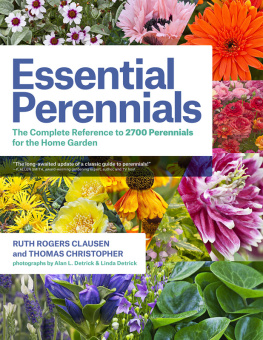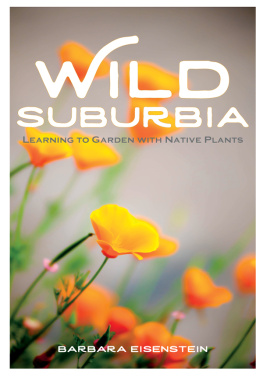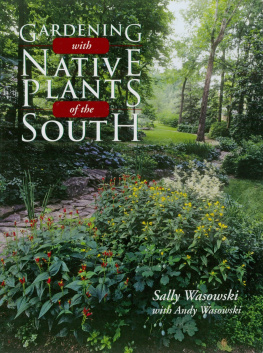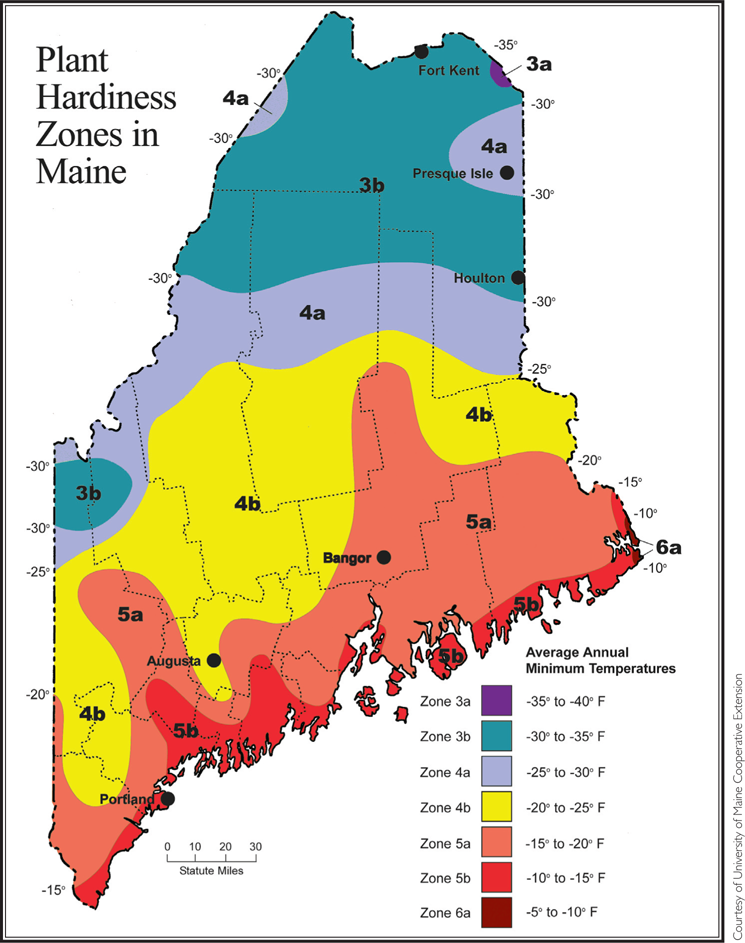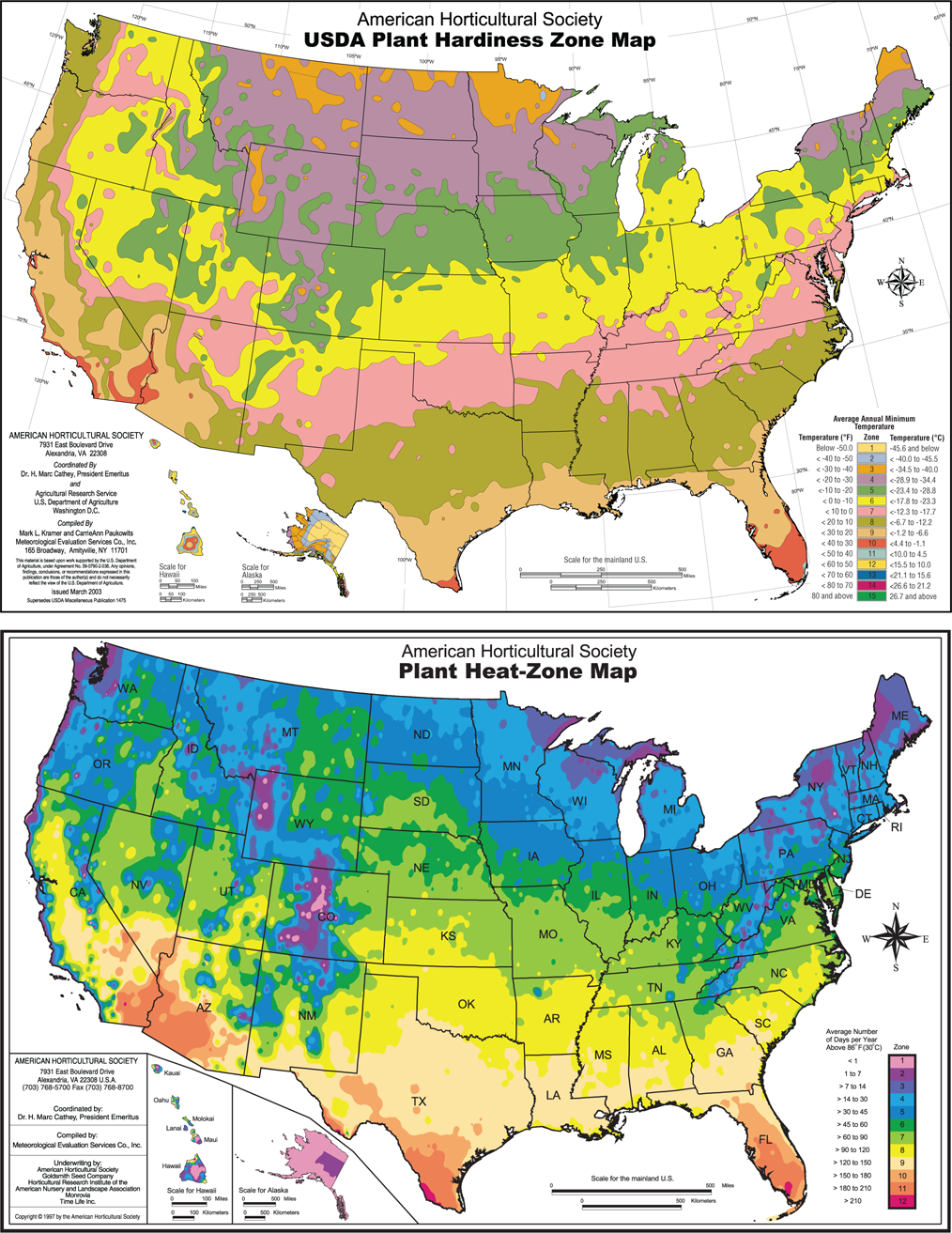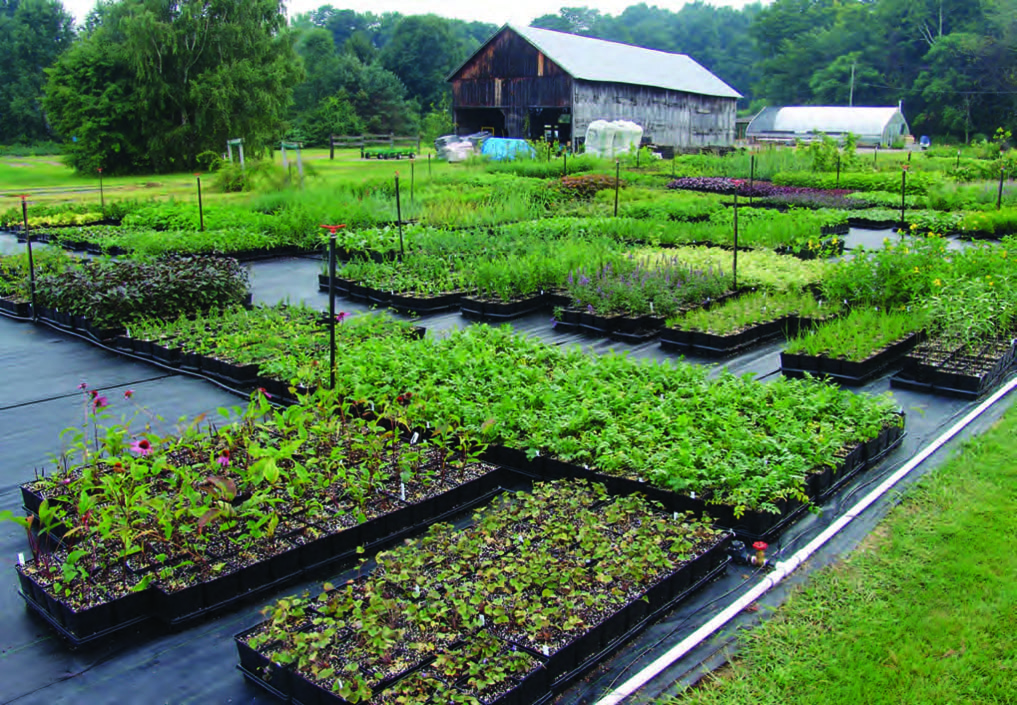Appendixes
Nonnative Invasives
The University of Maine Cooperative Extension service lists some of the most invasive nonnative plants that can dominate or choke out native vegetation. They are extremely difficult to eliminate once established.
Alliaria petiolata garlic mustard
Berberis thunbergii Japanese barberry
Celastrus orbiculatus Asian bittersweet
Deschampsia caespitosa ssp. parviflora small-flowered tickle-grass
Fallopia japonica Japanese knotweed
Frangula alnus and Rhamnus cathartica smooth and common buckthorn
Lonicera spp. nonnative honeysuckles
Lythrum salicaria purple loosestrife
Phragmites australis common reed
Rosa multiflora multiflora rose
Asian bittersweet, Celastrus orbiculatis
Maine and USDA Hardiness Zones Maps
One of the primary limiting factors in where a plant can grow is the average low temperature of any given site.
Plant scientists have developed a hardiness zone map that assigns a zone number to a region so gardeners can use it as a guide in selecting plants that will survive in their area. Maines growing zones range from 3 to 6.
There are two extremely useful temperature maps for gardeners in Maine and the Northeast: the USDA Plant Hardiness Zone Map, which shows the entire United States and eleven regions that are defined by the lowest average annual temperature, and the Plant Hardiness Zones in Maine Map. The latter divides Maine into areas with the same average yearly minimal temperature.
Remember that these are averages, and in some winters the temperatures can reach well below the average low. Therefore, you may want to select plants that are hardier than your particular zone to help ensure that more of your garden plants can withstand Maines cold winters. For example, if you live in Zone 5 in Maine and are a cautious gardener, you may want to select all or some plants that are hardy to Zone 4 and up, so that even in extremely cold winters, the plants will likely survive.
Also, consider the microclimates you may have in your garden. Lower elevations or lower-lying spots in your yard can be cooler than higher spots in your landscape because cold air is heavier than warm air and can pool in low spots. Marginally hardy plants positioned in sheltered, wind-protected areas may also survive winters that are colder than usual.
This easy-to-use zone map is for Maines temperature zones only. Keep in mind that areas along the coast, even coastal areas farther down east, can be warmer (and have a higher zone number) because of the moderating influence of ocean waters on land temperatures.
Nursery, Garden Center, and Online Sources for Native Plants
Be sure to purchase plants from reputable nurseries that responsibly propagate native plants. Although most nursery growers and sellers are responsible, some commercial sellers dig plants in the wild, especially rare wildflowers that are difficult to find elsewhere. For prized plants such as trillium, whose seed-to-market growing time is excessive, ask the grower or owner for the source of the plants, especially if the prices are extremely low or similar to those of commonly available plants.
The University of Maine Cooperative Extension service publishes a list of wholesale and retail Maine nurseries and garden centers that offer responsibly propagated native plants. The list indicates whether the business sells trees, shrubs, ferns, perennials, groundcovers, and/or vines: www.umext.maine.edu/onlinepubs/htmpubs/2502.htm (Native Plant Bulletin #2502).
Nasami Farm , in Whately, Massachusetts, is an excellent source of New England native plants. The farm is owned and operated by the New England Wildflower Society, based in Framingham. It offers a wide selection of native species, including hard-to-find woody plants. For visiting and purchasing information, visit the NEWFS Web site at www.newfs.org.
Web site: www.plantnative.com offers a helpful summary of native plants suitable for Maine, Vermont, and New Hampshire gardens with links to native-plant nurseries in each state. It also provides environmentally friendly garden designs and maintenance tips, and useful guidelines for designing gardens for wildlife.
Open seasonally, the New England Wildflower Societys Nasami Farm and Sanctuary in Whately, Massachusetts, sells plants to both the public and the landscape trade.
Photograph New England Wildflower Society/W. Cullina
Information Resources
Center for Plant Conservation
Missouri Botanical Garden
www.mobot.org/CPC
Useful information on native plants, including rare and endangered species. Promotes conservation organizations and projects that grow and conserve native plants and raise awareness of plants important role in our ecosystems.
Josselyn Botanical Society
Deering Hall, University of Maine, Orono, ME 04469 Maine native-plant society offering information, classes, workshops, and lectures on native plants.
Lady Bird Johnson Wildflower Center
www.wildflower.org Advocates for the preservation and use of wildflowers and native plants.
Maine Department of Conservation
Maintains a Web site (www.maine.gov) with information on public reserve lands that safeguard rare and endangered native plants. The Web site also offers a list of endangered and threatened wild plants and articles on creating backyard wildlife habitats and feeding wild birds, among other subjects.
Maine Natural Areas Program
www.mainenaturalareas.org 157 Hospital Street, State House Station, #93, Augusta, ME 04333 207-287-8044 Excellent information resource with publications on native plants, invasive species, Maines natural ecosystems, and other related ecological and conservation subjects. Free booklets and brochures on native-plant topics, including endangered plant species, Maine sources of native plants, and gardening to conserve Maines native plants.
National Wildlife Federation
www.nwf.org Helpful information on gardening in an environmentally friendly way, and creating and maintaining backyard wildlife habitats using native plants, including providing a water source and designing places for cover.
New England Wildflower Society
www.newfs.org Excellent resource for information and educational programs on native plants. Also operates a wholesale and retail native plant nursery (Nasami Farm) in Whately, Massachusetts.
University of Maine Cooperative Extension
www.umext.maine.edu Numerous publications on native plants for Maine gardens, and gardening to preserve Maines landscape. The information is available on their Web site or by calling your local county extension office.
Bibliography
Beaubaire, Nancy. Native Perennials: North American Beauties . New York: Brooklyn Botanic Garden, 1998.
Burrell, C. Colston. Native Alternatives to Invasive Plants . New York: Brooklyn Botanic Garden, 2007.
. Wildflower Gardens: 60 Spectacular Plants and How to Grow Them in Your Garden . New York: Brooklyn Botanic Garden, 1999.
Cullina, William. The New England Wildflower Society Guide to Growing and Propagating Wildflowers of the United States and Canada . Boston, MA: Houghton-Mifflin, 2000.


